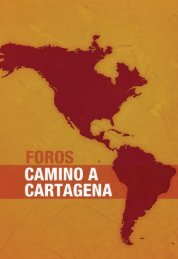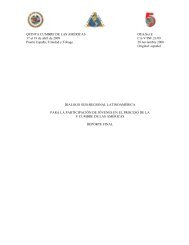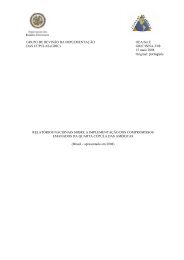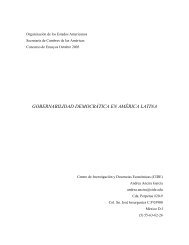The Road to Hemispheric Cooperation: Beyond the Cartagena
The Road to Hemispheric Cooperation: Beyond the Cartagena
The Road to Hemispheric Cooperation: Beyond the Cartagena
Create successful ePaper yourself
Turn your PDF publications into a flip-book with our unique Google optimized e-Paper software.
mented by Latin American countries. O<strong>the</strong>r summits in<br />
<strong>the</strong> Western Hemisphere were convened more than a<br />
generation ago, in <strong>the</strong> context of <strong>the</strong> Cold War in 1956<br />
and 1967. <strong>The</strong>se focused on <strong>the</strong> size and shape of U.S.<br />
aid programs and <strong>the</strong> relationship between trade preferences<br />
and immediate security concerns. 7 Since World War<br />
II, <strong>the</strong> intellectual climate and objectives for hemispheric<br />
cooperation have shifted. Throughout <strong>the</strong> period of “Old<br />
Regionalism”—from 1950 <strong>to</strong> 1975—regional agreements<br />
such as <strong>the</strong> Central American Common Market, Andean<br />
Pact, or <strong>the</strong> Caribbean Community and Common Market<br />
(CARICOM), initiated <strong>the</strong> pathways for developing a common<br />
market, but implementation was at times incomplete.<br />
Since <strong>the</strong> late 1970s, Latin America has undergone a<br />
process of political transformation—from authoritarian <strong>to</strong><br />
democratic regimes—which paralleled economic reforms.<br />
During <strong>the</strong> democratic transformation in <strong>the</strong> region, which<br />
Hunting<strong>to</strong>n identified as part of <strong>the</strong> global “third wave” of<br />
democratization, <strong>the</strong> number of democratic LAC countries<br />
increased from three in early 1978 <strong>to</strong> 15 democracies or<br />
semi-democracies in 1992. 8 <strong>The</strong> United States re-engaged<br />
<strong>the</strong> region with a bipartisan consensus of promoting democracy.<br />
After <strong>the</strong> late 1990s, <strong>the</strong> pattern has been mixed,<br />
with some advances and setbacks, but continues strong,<br />
with <strong>the</strong> number of elec<strong>to</strong>ral democracies reaching near<br />
100 percent. On <strong>the</strong> economic side, <strong>the</strong> debt crisis in <strong>the</strong><br />
1980s encouraged countries <strong>to</strong> replace import substitution<br />
and active state intervention. In <strong>the</strong> 1990s, <strong>the</strong> hemisphere<br />
moved decisively away from trade as aid <strong>to</strong>ward adopting<br />
trade liberalization, structural reforms, and privatizing state<br />
owned enterprises.<br />
1994 and <strong>the</strong> <strong>Road</strong> <strong>to</strong> Regional Integration<br />
<strong>The</strong> momentum <strong>to</strong>ward building regional democracy and<br />
implementing market-based policies reached its apex during<br />
<strong>the</strong> Summit of <strong>the</strong> Americas in Miami in December<br />
1994. Unlike <strong>the</strong> previous Cold War era summits, <strong>the</strong> 1994<br />
Miami Summit provided a unique forum <strong>to</strong> establish a<br />
common agenda for trade and social issues among democratically<br />
elected leaders in <strong>the</strong> hemisphere. <strong>The</strong> Miami<br />
Summit renewed aspirations for achieving hemispheric<br />
integration beyond post-World War II security pacts. Most<br />
were also implementing structural reforms and fiscal responsibilities<br />
embodied in <strong>the</strong> Washing<strong>to</strong>n Consensus.<br />
In fact, 1994 is a year <strong>to</strong> remember in <strong>the</strong> his<strong>to</strong>ry of regional<br />
integration in LAC. That year, a menu of options opened up<br />
for LAC <strong>to</strong> decide <strong>the</strong> course of economic integration in our<br />
region. First, <strong>the</strong> launching of <strong>the</strong> FTAA negotiations during<br />
<strong>the</strong> Miami Summit. Second, <strong>the</strong> successful negotiation<br />
of NAFTA as <strong>the</strong> first modern North-South FTA among <strong>the</strong><br />
United States, Canada and Mexico. Third, <strong>the</strong> cus<strong>to</strong>ms union<br />
agreement in Mercosur. And fourth, at <strong>the</strong> multilateral level,<br />
<strong>the</strong> conclusion of <strong>the</strong> Uruguay Round. All of <strong>the</strong>se were completely<br />
different models of integration—potentially complementary<br />
but in practice representing different paths <strong>to</strong>ward<br />
integration. I have called this <strong>the</strong> “Italian” menu of integration:<br />
(a) <strong>the</strong> “pizza” menu, or an homogenous model for <strong>the</strong><br />
whole hemisphere (FTAA); 9 (b) <strong>the</strong> “ravioli” menu, or <strong>the</strong> subregional<br />
model of integration with deeper integration pursued<br />
under <strong>the</strong> traditional blocks (Mercosur, Central America,<br />
Andean, and Caribbean groupings); and (c) <strong>the</strong> “spaghetti”<br />
menu, or <strong>the</strong> expanding web of bilateral agreements based<br />
on <strong>the</strong> NAFTA model of integration. We all know by now that<br />
<strong>the</strong> most preferred choice was <strong>the</strong> “spaghetti bowl” of multiple<br />
and overlapping FTAs that have been signed and implemented<br />
since <strong>the</strong> mid-1990s among countries in <strong>the</strong> region,<br />
and later on with partners in Europe and Asia. Most recently,<br />
a new item was added: <strong>the</strong> so-called “lasagna” menu, under<br />
which this spaghetti bowl is being flattened out in<strong>to</strong> lasagna<br />
through a process of harmonization and convergence among<br />
existing agreements (i.e., <strong>the</strong> Pacific Alliance). Figure 2 lists<br />
<strong>the</strong> intraregional and extra-regional FTAs in force, under implementation,<br />
or proposed.<br />
Most of <strong>the</strong> bilateral and regional PTAs in <strong>the</strong> Western Hemisphere<br />
were modeled under <strong>the</strong> original NAFTA blueprint,<br />
although some include more comprehensive provisions<br />
for goods, services, and investment—with also-increased<br />
provisions for beyond-border integration, such as government<br />
procurement, intellectual property rights, competition<br />
policy, and dispute settlement mechanisms. Post-2002<br />
PTAs include even deeper disciplines with greater transparency<br />
and economic integration measures. For example,<br />
<strong>the</strong> Canada-Chile PTA includes provisions <strong>to</strong> eliminate antidumping<br />
and substitute safeguard disciplines.<br />
<strong>The</strong>re is ano<strong>the</strong>r structural change in recent times, as demonstrated<br />
in Figure 2, with LAC countries increasingly focusing<br />
on trade with Asia. <strong>The</strong> volume of trade between<br />
LAC and Asia has grown six-fold since 2000, reaching<br />
<strong>The</strong> <strong>Road</strong> <strong>to</strong> <strong>Hemispheric</strong> <strong>Cooperation</strong>: <strong>Beyond</strong> <strong>the</strong> <strong>Cartagena</strong> Summit of <strong>the</strong> Americas<br />
<strong>The</strong> Brookings Institution ❘ Latin America Initiative<br />
25








